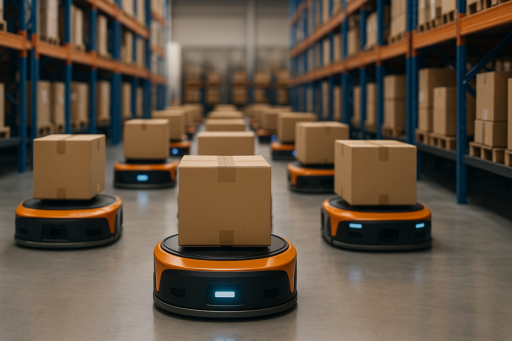
Will the robots eventually take over? That’s still an open question, but if sheer ability is the criteria, the answer is a definite – yes. Already, robots can do almost anything a human can – no less a personage than Bill Gates describes their capabilities as “limitless” – and they are still in their infancy. For businesses, robots mean efficiency and lower costs, especially in factories, warehouses, and other facilities that require significant human labor; at least that’s how they’re perceived.
However, managers often assume that replacing human workers with robots results in a staff that works for zero dollars per hour – and can work 24/7, if needed. While robots – and other autonomous and automated mobile equipment (AMRs and AGVs), as well as vehicles and forklifts – do cost money, the thinking is that given the reduction in expenses for the labor they replace, the return on investment should be great.
But that’s not necessarily true; many managers are not fully aware of or do not give enough weight to the fact that robots and autonomous mobile equipment come with their own expenses, some direct and some hidden. Some of the hidden costs that managers often don’t consider, but should, include- robots’ downtime due to charging, computer upgrades to manage the fleet, lost storage or production space – and even traffic jams.
Downtime inefficiencies
Robots and automated moving equipment run on batteries – and those batteries need to be charged. The charging time depends on the size of the robot or vehicle, but it could be as much as 20% of the time they are supposed to function. In addition, data shows that other issues often keep robots down for another 12% of their time, meaning that many robots could be offline for as much as a third of the time managers expect them to be working. That downtime – when a machine isn’t available to do the job – needs to be reflected when computing ROI.
Beyond the downtime, small interruptions or mistakes in the work cycle could cause other inefficiencies for automated robotic fleets. For example, in many warehouses, picking is done by robots, while packing and order verification is done by humans. If a robot fails to pick and deliver an item to the packing area, or brings the wrong item, the worker can’t complete that order, and the whole system is often paused, setting off a ripple effect of delays and idle robot time. And if the company is committed to shipping the same day, as many online sites require suppliers to do, that could cause a ripple effect of disappointed customers and lost business as well.
Expanding the Fleet Means Expanding the Budget
To compensate for the downtime most robots require, many warehouses or factories have a backup fleet – as many as 35% more robots or machines to pick up the slack for charging and maintenance downtime. Affiliated expenses for those extras include additional maintenance and battery replacement (as often as once a year). But one expense that is not likely taken into account is the need for a more robust server, in order to control the additional robots or machines. That could require a significant investment in new hardware and software – an expense that could certainly affect ROI calculations.
In addition, the extra robots may require even more maintenance than anticipated. Robots that sit idle are subject to additional maintenance issues, such as lubrication degradation, drained backup batteries, accumulation of dust in sensors, and motor problems. If robots are inactive as much as 20% of the time- as many are- that could mean a commensurate increase in extra maintenance costs to deal with these issues associated with prolonged periods of inactivity,
Don’t Forget to Consider Lost Space
Robots need power, and in standard warehouse and factory setups, that means allocating space for chargers and docking stations, often 10 square feet or more per charger. That extra real estate space costs money – whether in leasing costs, purchase of land, and real estate taxes – and those expenses need to be included when computing ROI. That also assumes there is even space to be added; while that’s unlikely to be a problem in large distribution centers usually far out of town, it could be a major issue for companies that have opened up smaller warehouses in cities and suburbs to better accommodate same-day delivery. In any case, when space is occupied by chargers or docking stations, it cannot be used for other purposes, and could hold back the ability to expand or scale.
More space for charging means less space for merchandise – which means more transport costs bringing items from distribution centers to urban and suburban warehouses, more waiting time for orders to be fulfilled, and more inventory and tracking issues. This, too, could result in missed or incorrect orders – and another black eye with customers. One solution would be to just expand the warehouse to compensate for the extra required space; another would be to add vertical shelving to accommodate more goods if floor space is not available. But those solutions, too, cost money – meaning that ROI would likely take a significant hit.
Robot Traffic Jams Are a Real Risk
With more robots on a factory or warehouse floor, there is a greater possibility that they will collide with each other or with human workers . Those collisions could lead to damage, injuries and other major problems. When robots collide with each other, they will likely need to be repaired, adding to maintenance costs, and causing the facility to become even less efficient because now it doesn’t have enough robots to cover charging down time. And if a robot hits a human, victims might sue – so facilities need to increase their insurance to cover potential losses. Managers can opt for collision detection systems, but those cost money, too. Although most facility managers are unlikely to have them in mind, these factors could seriously compromise ROI estimates.
Clearly, the ROI of robots is not a simple matter. Those who take into account the big picture and include all these hidden costs may indeed be disappointed or put off automating their warehouses. But there are ways to further offset these costs and boost ROI. AI shows promise in solving robot traffic jams, but when a facility needs to add extra robots to compensate for charging downtime, the algorithm needs to be adjusted – which could again require a software or hardware upgrade, or hiring AI experts to change controller systems.
One promising solution in solving some of these issues lies in innovative charging methods that reduce or even eliminate the need for charging downtime. These methods, such as enabling robots to charge as they work, for example, could reduce the need for fleets of backup robots and solve some of the challenges of associated with idle time, crowded work floors or warehouses, time lost waiting for robots to complete their task, space lost to charging docks, and expenses related to controlling fleets.
Automation is indeed the future, experts believe; the number of fully automated warehouses in the US has been steadily rising for nearly a decade. In addition, logistics and warehouse personnel are increasingly hard to find, and same-day delivery has boosted the need for a reliable staff. That automation trend is likely to continue, especially as more solutions to the issues surrounding charging, robot downtime and traffic jams, and logistics are solved, making the real ROI of automation much more attractive. Until that happens, though, facility managers and owners need to take into account the hidden costs of automation, and ensure that they are accurately figured into their ROI figures. Automation can indeed benefit an organization’s bottom line – if it knows what it’s getting into, and can control the hidden costs.
The post Can Robots Really Boost ROI in Warehouses and Factories? appeared first on Unite.AI.


